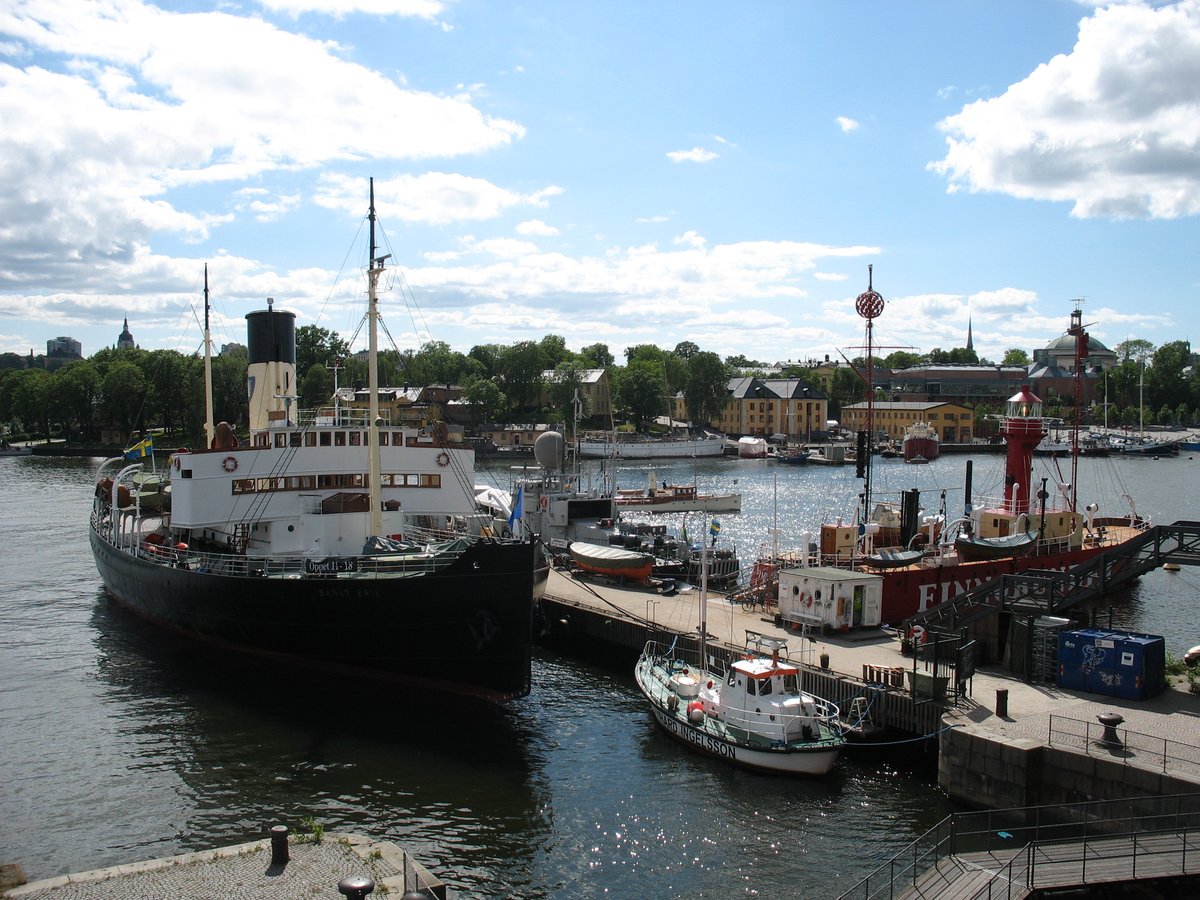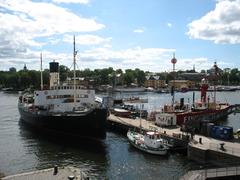
Lightship Finngrundet Visiting Guide: Stockholm’s Historic Maritime Landmark
Date: 14/06/2025
Introduction: Lightship Finngrundet—A Beacon of Swedish Maritime Heritage
Located on Stockholm’s picturesque Djurgården island, Lightship Finngrundet is a floating museum that encapsulates over six decades of Swedish maritime history and innovation. Originally constructed in 1903, this vessel served as a vital navigational aid on the Baltic’s hazardous Finngrundet shoal until its decommissioning in 1969. Today, moored alongside the Swedish National Maritime Museum, it offers an immersive experience into the world of early 20th-century navigation, technological evolution, and the daily lives of the crews who kept its beacon shining.
Whether you’re a history buff, family, or curious traveler, this comprehensive guide covers the ship’s historical significance, visiting hours, tickets, accessibility, nearby attractions, and practical tips to help you plan a memorable visit.
For the latest updates and additional details, consult the Swedish Maritime Museum’s official website, or explore related resources (Swedish Maritime Museum; Stockholm Maritime Museum).
Table of Contents
- Historical Overview
- Practical Visitor Information
- Onboard Experience & Highlights
- Visitor Tips & Accessibility
- Nearby Attractions
- FAQs
- Preservation & Modern Context
- Plan Your Visit & Further Resources
- Sources
Historical Overview
The Role of Lightships in Swedish Maritime Navigation
Before the advent of electronic navigation, Swedish mariners relied on visual beacons for safe passage through the Baltic’s perilous waters. In locations where building a lighthouse was impossible, lightships like Finngrundet were anchored to serve as floating lighthouses, marking dangerous shoals and sandbanks (Britannica, lightship). The Finngrundet shoal, notorious for its shifting sands, was among the most challenging areas, prompting the deployment of several lightships over the years.
Construction and Service Life of Finngrundet
Built at Kockums Mekaniska Verkstad in Malmö in 1903, Lightship Finngrundet’s riveted steel hull (31 meters long, 6.7 meters wide) was designed to withstand the harsh conditions of the open Baltic (Swedish Maritime Museum). Originally fitted with a kerosene-powered lantern and later upgraded with electric lighting and radio communications in the 1930s, the ship exemplifies the evolution of maritime technology in the early 20th century.
Crewed by 7–10 men, the vessel’s crew would live aboard for weeks at a time, maintaining the light, foghorn, and other navigational signals—often under challenging conditions.
Decommissioning and Preservation
Advancements in automated lighthouses and radar rendered manned lightships obsolete. In 1969, Finngrundet was retired and preserved as a museum ship, now serving as a vital educational and cultural resource at the Swedish Maritime Museum.
Practical Visitor Information
Location & Getting There
- Address: Galärvarvet, Djurgården, Stockholm, Sweden
- Access: Easily reached by tram 7, buses, ferries from Slussen/Nybroplan, or a 20–30 minute walk from the city center (Timeout Stockholm).
Opening Hours & Tickets
- Season: Open to visitors May–September (closed in winter).
- Hours: 10:00–17:00 (check official site for updates).
- Tickets:
- Adults: 120–160 SEK (prices may vary by season and source)
- Discounts for students, seniors, and children under 18
- Family and group rates available
- Admission typically includes access to both Finngrundet and the icebreaker Sankt Erik
- Purchase online or at the museum entrance
Accessibility
- Main deck is accessible via gangway.
- Lower decks/engine room may be inaccessible for those with limited mobility due to steep stairs and narrow passageways (Sjöhistoriska).
- Contact the museum in advance for specific needs.
Facilities
- Restrooms: At the nearby Maritime Museum
- Café: Onsite and nearby options for Swedish fika or a meal
- Gift shop: Maritime-themed books and souvenirs
Onboard Experience & Highlights
Explore Authentic Maritime History
- Deck & Lantern Mast: See the original lantern tower, fog bell, and signaling equipment
- Crew Quarters: Experience life below deck, with authentic bunks and galley
- Engine Room: Learn about the transition from kerosene to AGA electrification, and see historic machinery
- Weather Station: Displays of period instruments used for maritime meteorology
Tours and Interpretation
- Self-guided: Informational panels in Swedish and English detail the ship’s history and technology
- Guided tours: Offered during peak seasons and special events, often in collaboration with maritime heritage organizations
Interactive & Educational Activities
- Try flag signaling or Morse code
- Participate in hands-on workshops and storytelling events during festivals
- Special children’s activities during school holidays
Visitor Tips
- Dress warmly and in layers: The ship is exposed to the elements, even in summer
- Photography: Permitted for personal use (no flash/tripods without permission)
- Cashless: Stockholm venues primarily accept card payments
- Combine visits: Make the most of your trip by exploring other Djurgården museums
Nearby Attractions
- Icebreaker Sankt Erik: Museum ship moored nearby
- Vasa Museum: 17th-century warship exhibition
- ABBA Museum & Skansen: Cultural and family-friendly attractions
- Djurgården’s parks and cafés: Ideal for a post-visit stroll or meal
Frequently Asked Questions
Q: What are the opening hours?
A: Typically 10:00–17:00, May–September. Check the official website for updates.
Q: How much are tickets?
A: 120–160 SEK for adults; discounts for children, students, and seniors.
Q: Is the ship accessible for people with disabilities?
A: Main deck is accessible; lower decks may not be. Contact the museum for assistance.
Q: Are guided tours available?
A: Yes, during peak seasons and events; often included in admission.
Q: Can I take photos?
A: Yes, for personal use.
Q: Where is Finngrundet located?
A: Galärvarvet, Djurgården, Stockholm, next to the Maritime Museum.
Preservation & Modern Context
The Swedish Maritime Museum actively preserves Finngrundet, collaborating with historians and former crew to keep its legacy alive (Swedish Maritime Museum). The ship’s story connects the past with the present, as the Finngrundet shoal area remains an important site for Swedish maritime innovation, now hosting renewable energy projects (4C Offshore).
Plan Your Visit & Further Resources
- Download the Audiala app for self-guided audio tours.
- Check the Swedish National Maritime Museum for up-to-date information, special events, and visitor services.
- For group bookings or tailored educational visits, contact the museum by phone (+46-8-519 549 00) or email ([email protected]).
Sources
- Swedish Maritime Museum: Finngrundet
- Stockholm Maritime Museum
- Official Lightship Finngrundet Visitor Info
- Visitor Guide: Sjöhistoriska museet
- Timeout Stockholm Travel Tips
- Britannica: Lightship
- 4C Offshore: Finngrundet Wind Farm
Conclusion
Lightship Finngrundet remains a must-see historical site in Stockholm, offering an engaging blend of maritime history, technology, and human stories. Its central location, rich programming, and preserved authenticity provide a unique window into Sweden’s nautical heritage. Plan your visit for an unforgettable journey into the world of Baltic seafaring.





































































































































































